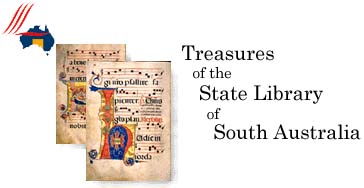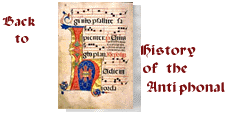Pre-treatment investigation
Before any treatment commenced, it was important
that the Antiphonal was thoroughly examined so that its condition
could be assessed and so that the evidence of its physical history
could be recorded.
An interesting picture of the binding history of
the book emerged during the examination. The binding is definitely
not original - apart from anything else, the pre-treatment binding
was not a 13th century binding.
 Having examined the evidence within the book, we
are able to say with some confidence that the book has been rebound
about three times since the original binding was removed. This
evidence included:
Having examined the evidence within the book, we
are able to say with some confidence that the book has been rebound
about three times since the original binding was removed. This
evidence included:
- multiple sewing stations and fragments of different
sewing threads, indicating that the book had been sewn a number
of times,
- layers of different leathers on the spine of
the book,
- repairs to the backfolds of the all the folios.
It is also very clear that one of the binders trimmed
the book down from a larger size, cutting text on the foredge
margin in half.
In addition, a number of different styles of repair
were found within the textblock. A sample of each was retained
so that this information is still available to future generations.
 When the Antiphonal conservation project commenced,
the book had a number of problems that threatened its future survival:
When the Antiphonal conservation project commenced,
the book had a number of problems that threatened its future survival:
- the spine leather had split, leaving the boards
loose and unable to adequately protect the vellum leaves. This
also made the book - which is quite heavy - very awkward to handle
- the sewing had failed, becoming very loose in
some places and allowing vellum leaves to protrude beyond the
rest of the textblock. These leaves were very vulnerable to "wear
and tear".
- the black musical notation in the book was beginning
to crumble, leaving small deposits of pigment in the spine gutter
margins. Movement in the textblock, caused by the loose sewing
and loose boards, led to abrasion of the text as the leaves moved
over one another. If this was allowed to continue the text would
have worn away. The rate of pigment loss would have been closely
related to the amount of use the book received.
- many of the old repairs were stiff, over-glued
and restricted the flexibility of the vellum. Some had to be removed
so that the original vellum did not split along the edge of the
repair.
- many of the vellum leaves were cockled and distorted.
Some distortions were due to poor repair techniques, others resulted
from vellum's extreme sensitivity to fluctuations in relative
humidity. All were quite "set" into the vellum and affected
adjacent leaves.
Following this detailed examination, a treatment
proposal was drawn up for the Antiphonal. It was vital that the
treatment rectified the major problems, without compromising the
integrity of the book and without creating new problems.
As each treatment step was completed it was necessary
to assess its effects and to determine whether any changes needed
to be made to the treatment proposal.



